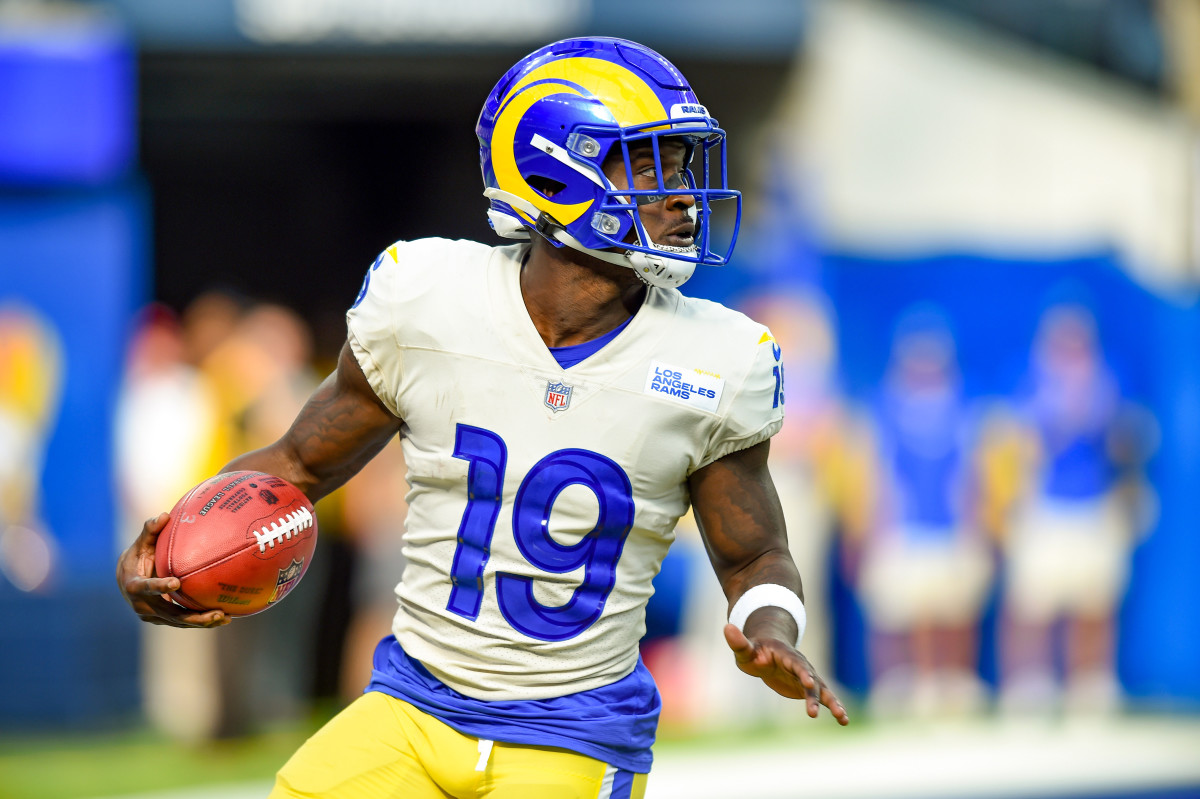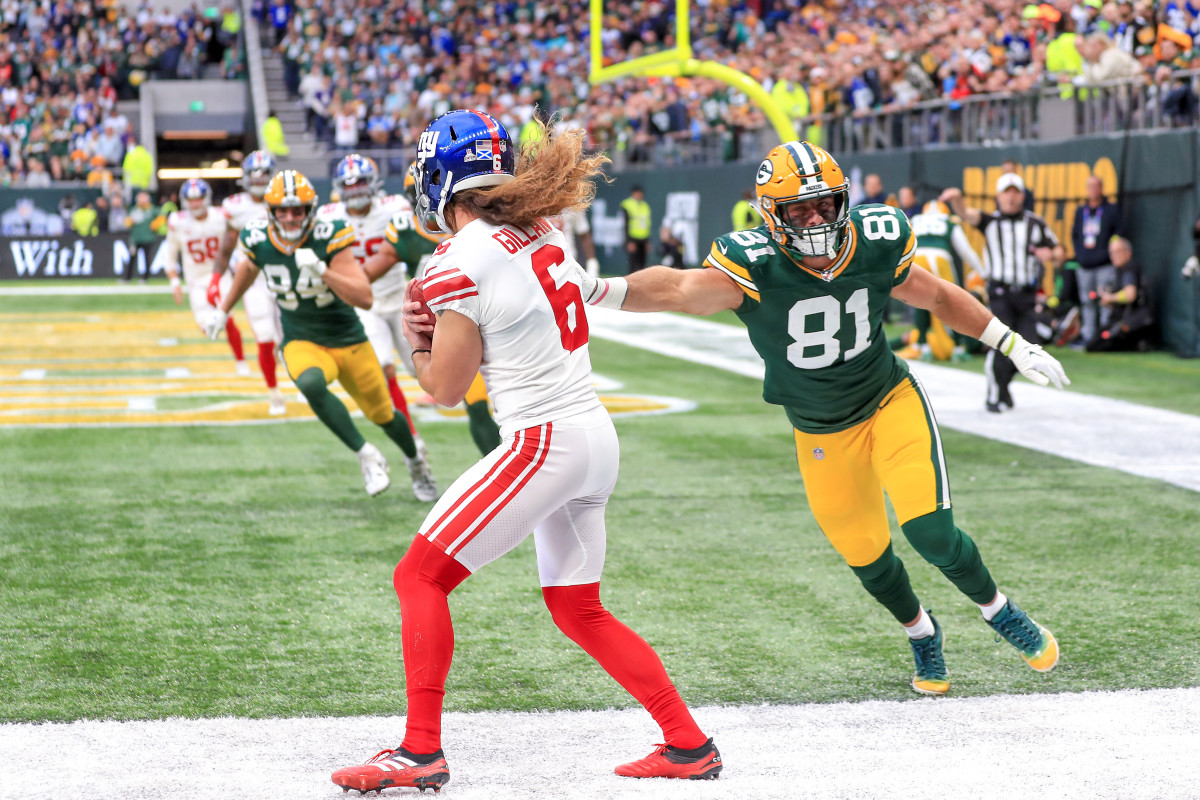The Chaos and Beauty of the Intentional Safety

An undrafted free agent who bounced between four teams before joining the Rams last season, Brandon Powell has become indispensable for the defending Super Bowl champions. He runs routes as a wide receiver, takes some carries as a running back and serves as their primary kickoff and punt returner. Of all his many odd jobs, though, by far the oddest came with 13 seconds left in a Week 2 game against Atlanta, when the 27-year-old lined up at punter as Los Angeles clung to a 31–25 lead. “It was stressful,” Powell says.
Stationed along his 14-yard line, Powell shook off his jitters in time to snag the long snap from Matthew Orzech, no easy feat itself. (“I catch punts,” Powell explains. “I don’t sit back and catch punts that way.”) But instead of booting it on this fourth-and-7, or carrying out a fake, he tucked the ball under his right arm, turned tail over his right shoulder and retreated into the Rams’ end zone while a flock of Falcons gave chase. “Executed it perfectly,” says Powell, who eventually tip-toed out of bounds at the rear pylon with six seconds on the clock. “They got two points; we won the game.”

So goes the warped calculus behind the NFL’s silliest-possible scoring play, a delightful phenomenon—best set to the classic slapstick soundtrack of “Yakety Sax”—that temporarily swaps tactical seriousness for an old-fashioned game of keepaway. Sure, broadcasters do their best to maintain a hint of gravity in these moments. (“Smart play by the Rams,” Fox play-by-play man Kevin Kugler narrated, knowingly, as Powell’s retreat unfolded. “Those two points do not matter.”) But nothing they say can outweigh the true essence of the intentional safety, a totally sound coaching strategy built on the total inversion of two typically ironclad tenets of the sport: Don’t give your opponent free points. And don’t run the wrong way.
Indeed, intentional safeties are both a parody and a paradox. They are relatively rare, with just nine cropping up over the past nine-plus NFL seasons, yet rarely meaningful. (Least of all to sports bettors—per researchers at Caesars Sportsbook, none of those nine affected a cover or an over-under.) And while their intention is to help clarify the on-field outcome, they can also produce confusion in the stands: How many budding American football fans left London’s Wembley Stadium on Oct. 26, 2008, scratching their noggins after seeing then Saints quarterback Drew Brees flick the ball out of the back of his own end zone with all the casualness of a parent tossing a dirty diaper into the trash?
The beauty of intentional safeties lies in their schoolyard simplicity—and not just because, unlike a quarterback getting sacked in the end zone, it is the only instance when a safety actually lives up to its name. “It’s the idea that, when you’re backed up in your own end zone, it’s safer to give the other team two points than to punt,” Football Outsiders founder Aaron Schatz says. “It’s fun, it’s interesting.”
And, more than anything, it is a chaotically memorable experience for the select few who have pulled it off. Just ask former Panthers and Jaguars punter Brad Nortman, one of three players—Brees and ex-Ravens punter Sam Koch are the others—to have taken multiple career intentional safeties since the turn of the 21st century.
“You practice them as part of your general preparation, all these strange, potential plays you might run, but you don’t think you’re gonna use them,” Nortman says. “Sure enough, you play long enough, there are opportunities to do so. Then when they actually call it, you’re like, ‘Oh boy, here we go.’”

In October 1939, as the early stages of World War II raged overseas, a syndicated sports columnist named John Lardner—son of the famed writer Ring—devoted a large portion of a dispatch to praising a bit of strategy that happened on a fourth-down play in that year’s Yale-Army game.
“The young sophomore … Bill Bell, decided to save the day for Yale with an intentional safety,” Lardner wrote. “Twelve yards stretched between the place where he stood and his own goal-line. Could he make it? Could his blockers get around behind him and pave the way to the end zone before the Army tacklers intercepted the lad and swatted him down like a fly?”
This over-dramatic description carried on for a few more paragraphs as Bell triumphantly shook off the stymying attempts of two Army defenders who respectively “clutched the seat of his pants” and “jumped on his back”; as he plunged “with a final surge” into Yale’s end zone, burning enough time to secure a 20–15 win; and as he was saluted by a “whooping” crowd that “split the welkin with their cheers.” Summarized Lardner, “Personally, I think the trials and heroics of the intentional safety have been overlooked.”
Maybe so from Lardner’s press box perch, but it’s also clear that the intentional safety has been appreciated on the sidelines for nearly as long as football has existed, with the earliest newspaper references dating to the early 20th century. “If you’re a coaching staff that doesn’t have it in your repertoire, you’re not doing your job,” says former long snapper Steve DeOssie, who recalls working on hiking the ball through the uprights during designated “special teams days” at Giants and Patriots training camp under Bill Parcells in the 1990s. Still, though, not every player was familiar with the concept: Later on that decade, after Parcells instructed then-Jets quarterback Neil O’Donnell to chuck the ball from his own end zone into the seats with 16 seconds left in a six-point game against the Colts, a perplexed O’Donnell told reporters, “This is a play I learned today. I never heard of that type of situation before. I thought I knew all the rules.″
Fortunately, the rationale is easy enough to grasp. “Disaster happens less often after the free kick compared to a punt when pinned back,” Pro Football Focus analyst Timo Riske says. “These are slight advantages that matter a lot in these late game situations, [when] the two points are irrelevant if you can make sure the opponent isn't scoring anymore.” According to Riske’s data, teams that kick from inside their 5-yard line are nearly three times as likely to start the next drive on defense back inside their red zone via a blocked punt or a long return (5% of the time), than those who opt for the unblockable, more easily squib-able, post-safety free kick (1.8%).
As a fellow stathead, Schatz agrees. “When the time comes, it’s pretty self-evident,” he says. But, “I can’t be like, ‘Intentional safeties make sense, because your chances of winning are X percent,’ because they all come in completely different circumstances. I don’t even know if the play-by-play simulator we use has intentional safeties programmed into it. If you’re in a situation where you’re on your own 1 and up by seven with five seconds left, I don’t think that our simulator will spit out that the right choice is a safety, because it’s so rare. Why would you program it? Why would you take the time?”

Other than the pair that have happened this season—three weeks after Powell’s play, Giants punter Jamie Gillan killed five seconds by hopping around the end zone at Tottenham Hotspur Stadium in a win over the Packers—Schatz could recall only one intentional safety off the top of his head. And here his memory has little to do with Patriots coach Bill Belichick’s daring decision in November 2003 to call one while trailing by a point against the Broncos with 3:06 left (which improbably paid off when Denver misplayed the free kick and Tom Brady led a game-winning touchdown drive). “My daughter was born the week before,” Schatz says. “And I was trying not to make any noise while I watched the game.”
Without a doubt the most impactful intentional safety in NFL history occurred a little less than a decade later, in February 2013, with 12 seconds left in Super Bowl XLVII and Baltimore leading San Francisco by five points. “In a move straight out of a dorm room Madden game,” as SB Nation described it, Koch managed to whittle the clock down from 0:11 to 0:04 by scampering around the end zone before taking a hard shove out of bounds from a Niners player that caused the punter to nearly trip over a security rope. In so doing, Koch learned an important lesson about what it takes to properly execute such a unique play.
“It gives you a glimpse of what it’s like to be an NFL player, as opposed to a punter,” he says. “You get to see all these guys rushing after you, guys who tackle every day of their life, and you gotta make a smart decision, and a business decision—and that’s [to] get out of bounds when they get close.”

Taken third out of Miami in the 2003 NFL draft, Andre Johnson was sitting on the Texans’ bench near the end of the 10th game of his debut season when special teams coach Joe Marciano approached him with an unexpected request. Nearly two decades later, Johnson remembers the curious language that was used: “Hey, I need you to line up at punter, catch the ball and run out the back of the end zone.”
A former high school punter, Johnson initially thought that Marciano was asking him to hammer one deep on fourth-and-14, with three seconds left and the ball on Houston’s 34-yard line: “I was looking at him like he was joking. It took me a second to catch what he was asking me to do. It wasn’t something that we prepared for. It was just out of the blue.” But the rookie wideout had little trouble with the impromptu task, snaring the snap around the 20 and galloping through the Texans end zone as time expired. “I was like, ‘All right,’ got up, went in, did what I had to do to get the win,” Johnson says.
Not that the instructions are complicated for the person taking the intentional safety. “Make sure you catch the ball,” Nortman says, listing them off. “Then run to the corner of the end zone, place yourself by the line so you can step out, and don’t do anything stupid; don’t be a hero.” But potential pitfalls do exist. For Powell, the “toughest part” involved catching Orzech’s whizzing snap; for Nortman, the challenge was more mental. “All the things you’re taught not to do normally are all of a sudden okay,” the punter says. “It’s all opposite. You have to retrain your brain.”
Thanks to a bygone section of the NFL’s rulebook, the same used to be true for blockers up front. “The coaching points were hold, grab, tackle, do whatever humanly possible to prevent your guy from getting to me,” Nortman says. “The idea was if they throw a flag, it’s just going to run more time off the clock because they can’t add seconds back on.” So it was that Nortman “may have taken the slowest intentional safety in NFL history,” as the Charlotte Observer put it, standing idly by for 12 whole seconds in November 2015 to secure a 28-point win over Washington (also the biggest scoring margin for a successful intentional safety). “I remember after the fact, in film, us watching our punt team against their return team, and some guys were really taking it to heart, throwing them to the ground,” Nortman says.
Koch reaped the benefits of this strategy twice—once in the Super Bowl, and then again to secure a 19–12 victory against the Bengals three seasons later, when Koch moseyed around the end zone for the final 11 seconds while his fellow Ravens staged (and won) a tag-team wrestling match. “It was a pretty cool moment,” Koch says. “We used that loophole to our advantage.” The following spring, however, in March 2017, the league effectively closed that gap in the rules by imposing a 15-yard penalty (and, more critically, a resetting of the scoreboard time) upon teams that “commit multiple fouls during the same down in an attempt to manipulate the game clock.” Koch was sad to see it go, as was the headline of one news story about the crackdown that began, “NFL rule change bans brilliant strategy…”
Consequently, intentional safeties are less farcical these days. But, absent a total prohibition of the play—which seems unlikely—they will always remain a curious figure of interest to some. Koch, for instance, recalls he and then Ravens long snapper Morgan Cox continuing to “mess around” with different methods of taking intentional safeties during idle moments at practice. “Me throwing a ball, me running it, whatever it may be,” Koch says. “I enjoy doing things different, and it’s something different.”
Johnson’s famous intentional safety, meanwhile, saddled the seven-time All-Pro wideout with the NFL record for the fewest rushing yards logged in a single game, at minus-34. A couple of years later, that led to a memorable exchange with a young member of new Texans coach Gary Kubiak’s staff. “Kyle Shanahan was my receivers coach, and one of the first things he asked me and was like, ‘Why do you have so many negative rushing yards?’” Johnson says. “He couldn’t understand it.”
The trivia tidbit eventually formed an inside joke between Shanahan and Johnson over their two seasons together, from 2008 to ’09. “He’d always try to give me reverses to get my yards back,” Johnson says. But before all that Johnson recounted to his coach the story of the request that he received as a rookie, the brief confusion that followed, and the long backward jaunt that came after that—all those trials and heroics of the overlooked tactic that Lardner and others love so much.
“I told him about what happened, that I had to catch the snap and run out the back of the end zone,” Johnson says. “And he was like, ‘Now it makes sense.’”
